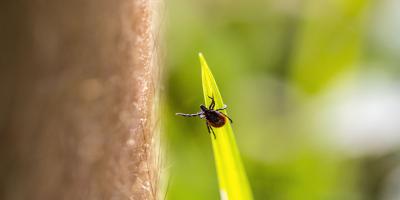Ticks: What are your risks in these four New England states?

Tick-borne illnesses can pose serious health risks to people and pets. According to the CDC, it is estimated that approximately 476,000 people each year are treated for Lyme disease as a result of a tick bite – and New England states are no exception. These states consistently rank in the Top 10 of states of reported Lyme disease cases in the country every year. As the weather warms, and you, your family, and pets begin spending more time outdoors, keep in mind that ticks are on the move and can easily latch on to you without you ever knowing.
Before you go hiking, biking, camping, or exploring the parks and beaches of New Hampshire, Vermont, Massachusetts, or Maine, be sure to take preventative measures.
In this article, you’ll discover what types of ticks you may encounter in each state, what time of the year they’re most active, and what types of diseases they’re capable of transmitting.
4 common ticks found in the northeastern region of the U.S.
Although there are several types of ticks that inhabit northeast states, the species of ticks most likely to transmit disease to humans and pets are the following:
- American dog tick (Dermacentor variabilis) This species of tick can be found east of the Rocky Mountains and is known for transmitting: Tularemia and Rocky Mountain spotted fever. Dog ticks do not transmit Lyme disease. This species of tick is most active during spring and summer.
- Blacklegged tick (Ixodes scapularis) This species of tick can be found across the eastern United States and is known from transmitting: Lyme disease, anaplasmosis, tick-borne relapsing fever, ehrlichiosis, babesiosis, and Powassan virus. The blacklegged tick is most active in the spring and fall, and even into the winter when temperatures are above freezing.
- Brown dog tick (Rhipicephalus sanguineus) This species of tick can be found worldwide and can spread Rocky Mountain spotted fever. Dogs are the preferred host. Although they are mostly encountered indoors (they do not fare well outdoors in the U.S.) they rarely bite humans.
- Lone star tick (Amblyomma americanum) This species of tick can be found in the eastern, southeastern, and south-central United States and is known for transmitting ehrlichiosis, Heartland virus, tularemia, and STARI. The lone star tick is also thought to be responsible for causing an allergic reaction known as alpha-gal syndrome (red meat allergy).
New tick species discovered in the U.S.
- Asian longhorned tick (Haemaphysalis longicornis) The Asian longhorned tick is an invasive species that poses a serious threat to livestock. This species of tick was first discovered in the United States in 2017. As of 2022, the Asian longhorned tick has been found in 20 states, including Massachusetts. Because it is a newly discovered species of tick, it’s unknown what type of diseases it is capable of spreading in a natural setting. However, in a lab setting, scientists found that it had the potential to carry and spread Rickettsia, the germs that cause Rocky Mountain spotted fever.
Tick statistics for these 4 New England states:
- New Hampshire – The blacklegged tick (deer tick) is widespread and concerning for its potential to spread Lyme disease, babesiosis, and anaplasmosis to humans.
The American dog tick is widely spread and frequently encountered in New Hampshire and is found in every county in the state. Although it is best known for carrying Rocky Mountain spotted fever (RMSF), reports of transmission are not very common. Height of activity for the American dog tick occurs in May and again in July.
Other less common species of ticks that are present and may pose a risk to people in New Hampshire are the brown dog tick and the lone star tick.
The result of climate change – extending springs and falls and shortening winters – is that Northeast states are seeing longer tick seasons, which increases the risk of tick-borne diseases that can be spread to people, pets, and wildlife. - Vermont – Blacklegged ticks (deer ticks) and American dog ticks are the two most notorious species of ticks in Vermont, and are well known for carrying disease-causing germs that are responsible for Lyme disease, babesiosis, anaplasmosis, Powassan virus disease, and Rocky Mountain spotted fever. However the tick you want to watch out for in the “Green Mountain State” is the blacklegged tick, which is responsible for over 99% of all tick-borne diseases according to the State of Vermont Agency.
The height of blacklegged tick season in Vermont occurs in mid April through May and then again in early October through November. Nymphs are most likely to bite in late spring and early summer, while adults search out hosts in spring and fall. American dog tick season typically begins in April and lasts through September. In addition to knowing what time of year ticks are most active, another thing to consider while you're outdoors is where you may encounter a tick.
When ticks search for a host, it’s referred to as the “questing season”. Typically nymphs will hide amongst leaf litter or low-lying areas that offer a blanket of vegetation, making anything that walks by a target, but especially small rodents. Adults take to the skies, hovering on tall grasses and twigs until an unsuspecting warm blooded mammal, such as a deer, dog, or human passes close enough for it to latch onto.
For more information about reported tick activity in Vermont, check out the Vermont Tick Tracker. Not only does it list the species of tick being reported, it also gives details about where the tick was found. - Massachusetts – Tick activity and tick-borne diseases occur year-round in Massachusetts. However, there are two times during the year when tick activity peaks, which may increase your risks of being bitten. The first peak time is March through April and the second is October through November. But because these peak times are weather-dependent, tick activity may occur earlier or later in the year.
The two species of ticks that are most abundant in Massachusetts are blacklegged ticks (deer ticks) and dog ticks, which can spread common tick-borne diseases such as Lyme disease, babesiosis, anaplasmosis, and other disease-causing germs. Although Lone Star ticks may not be as prevalent in this area, they still pose a risk.
According to a report published by the Massachusetts Department of Public Health, Bureau of Infectious Disease and Laboratory Sciences Tick Exposure and Tick-borne Disease Syndromic Surveillance Report, December 2022, the five counties that ranked the highest for tick exposure in 2022 were Berkshire, Franklin, Barnstable, Dukes, and Nantucket. Another interesting discovery was the age of patients diagnosed with a tick-borne illness were children ages 5-14 and older adults ages 45-84.
Stay protected with these tick-borne disease prevention tips from Mass.gov. - Maine – In 2022 Maine Center for Disease Control and Prevention Tracking Network reported probable or confirmed cases of tick-borne diseases as follows: 2,617 cases of Lyme disease, 824 cases of anaplasmosis, and 191 cases of babesiosis. The top three counties reporting tick-related emergencies in 2022 were Lincoln, Knox, and Handcock with the majority of incidents occurring in late May through early June and another spike of activity in the first week of November.
Blacklegged ticks (deer ticks) are the most abundant species along the southern coast of Maine, decreasing in numbers as they move inland.
Largely dictated by seasonal temperatures, tick activity can vary considerably from coastal communities to wooded inlands. The height of activity for blacklegged tick nymphs is from May through July. Adults are more active October through December and April through June. If you’re outdoors during these increased times of activity, use caution to avoid being bitten.
If you live in Maine and would like to have a tick tested, you can submit it for identification through the University of Maine Cooperative Extension Tick ID Lab.
Keeping tick populations in check
At JP Pest Services, our seasonal Tick Control Program uses integrated pest management (IPM) and includes three treatments per season – spring, mid-summer, and fall. An IPM approach takes into account: the environment, conducive conditions, prevention strategies, and assessing what pest control treatment will be the most effective for your pest problem. This combination is powerfully effective and offers long-lasting results.
Whether you’ve experienced a tick problem in the past, or you’re bracing for a particularly tick-heavy season, JP Pest Services can help get your situation under control so you can enjoy your outdoor space without worrying about being bitten by a tick.



